Automotive MCU Research: Chinese vendors pursue replacement of foreign peers in the context of “shortage of chips”.
Concentrated capacity and repeated outbreaks of the COVID-19 make it hard to relieve the shortage of MCUs at once.
MCU, a core chip for vehicle control, finds application in body control, driving control, infotainment and driving assistance. MCU is a mature market featuring a stable pattern. NXP, Infineon, Renesas, STMicroelectronics and Texas Instruments have long been the top five players in the global automotive MCU market where CR7 (hold by international giants) reached over 95% in 2020.
Automotive MCUs with multiple specifications are often produced with 40/45/65nm process, and the operating cost of production lines remains high. So most integrated device manufacturers (IDM) like NXP, Renesas, Infineon, Texas Instruments and Microchip Technology adopt the foundry strategy. Automotive MCU foundry is a highly concentrated industry. Globally, 70% of automotive MCUs are produced by TSMC. Yet MCU capacity makes up a mere 3% of TSMC’s total capacity.
As the pandemic in 2020 led to a slump in the demand from automotive industry, MCU vendors reduced their orders and digested their inventory. In 2021, the recovery of global automotive industry has caused a short-term short supply of automotive chips that need a long time to supply.
Since 2021Q2, Malaysia and Taiwan have underwent a much severer COVID-19 outbreak. Taiwan-based TSMC is a major MCU fab; Malaysia is home to OSAT companies of vendors such as NXP, Renesas and Infineon. As a result, automotive MCU industry may be hit hard again, taking a bigger toll on chip supply.
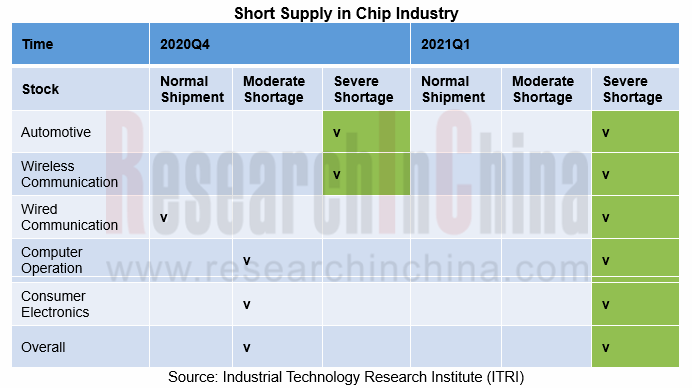
At present, most vehicle and component production suspensions are a result of the shortage of MCUs which are largely demanded by automakers. It is predicted that the lack of chips will last across 2021 but may be eased from 2022 for the following reasons.
(1) Suppliers and fabs race to expand their capacity. For example, Infineon will construct and put into use a new 12-inch fab in late 2021; in 2021, TSMC will produce MCUs 60% more than in 2020, and concentrate on the expansion of its Nanjing plant (28nm) for larger MCU capacity.
(2) Chinese companies are working to make deployments in MCU. They are expected to start mass production in 2022 to replace foreign products and mitigate the short supply of chips. An example is GigaDevice which plans to spawn its latest automotive MCU products in 2021.
In the long run, as vehicles tend to be intelligent, connected and electrified, the shortage of chips will become normal. The basic solution to the supply safety in China’s intelligent connected vehicle industry chain is to build an independent chip industry chain.
The short supply of chips will bring the window of opportunity to Chinese MCU industry
Through the lens of supply chain, MCU ecosystem covers a lot including a variety of software, hardware, development tools, and open source platforms used by end customers. China currently still depends heavily on foreign software and tools.
International manufacturers are in dire need of MCUs amid the short supply of chips. Automakers have begun to add purchase channels and candidate suppliers, which brings the window of opportunity to Chinese MCU vendors.
In China, few companies such as AutoChips, ChipON, Sine Microelectronics, Chipways, BYD and NationalChip can produce MCUs in quantities, among which BYD, Sine Microelectronics, ChipON and AutoChips can support OEMs, but their products are still used for controlling simple functions like windows, lighting and cooling system and rarely seen in power control, intelligent cockpit and ADAS, among other complex applications.
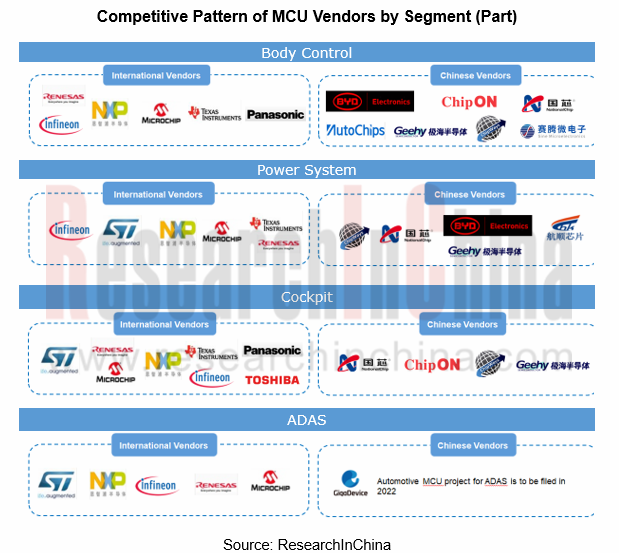
MCU is a platform-based product. With abundant product lines, overseas vendors provide full range of products for customers. At present, Chinese vendors are working to deploying MCU product lines of all series.
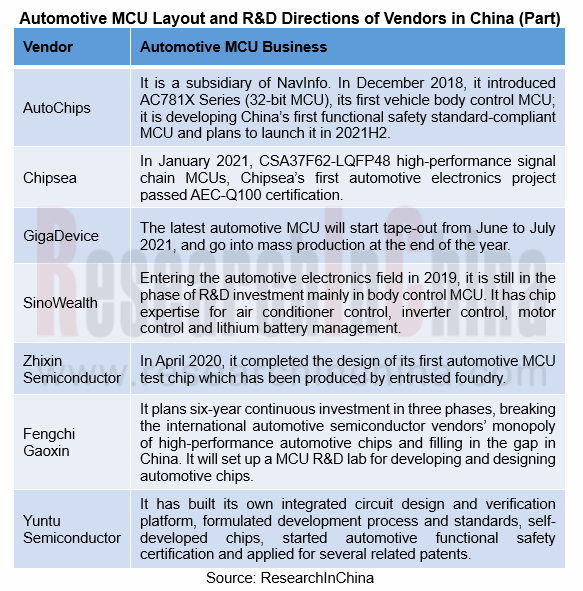
Chinese MCU vendors may make breakthroughs in the following two aspects:
Body control: MCU solutions for vehicle wireless charging, ambient light control and flowing water blinker rear light control, which were once available to high-class models, have now been largely used in low- and mid-class vehicles, and the demand will surge.
For example, Sine Microelectronics has rolled out MCUs for vehicle wireless charging and flowing water blinker rear light control, of which ASM87F0812T16CIT, a MCU master chip designed for vehicle LED flowing water blinker rear light has been shipped more than 1.5 million pieces as of January 2021.
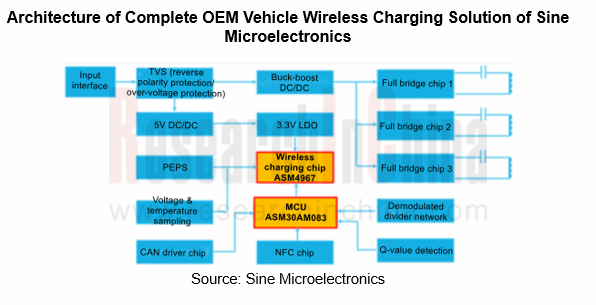
Power control: Chinese vendors have begun to introduce related products, but there are still no heavyweight products. Players that have products landed have more potential to replace foreign counterparts.
In May 2021, ChipON launched KF32A156, a new automotive MCU subject to AEC-Q100 standard and using kernel processor. KF32A156 is applicable to power supply, motor control and so on. With wider power domains than the previous products, the mass-produced MCU will be available to 70% body and power control unit modules compared with the previous 30%.
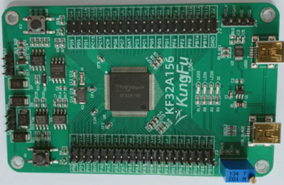
Building an independent industry chain is of vital importance in addition to improving layout of product lines. Coordinating the upstream and downstream resources of the industry chain from IP and chip design to foundry and OSAT helps to make homemade automotive MCUs safer, more stable and more reliable.
ResearchInChina’s Automotive Microcontroller Unit (MCU) Industry Report, 2021 highlights the following:
 Automotive MCU industry (favorable policies, market size, competitive pattern, industry chain, foundry, technology trends, etc.);
Automotive MCU industry (favorable policies, market size, competitive pattern, industry chain, foundry, technology trends, etc.);
 China Automotive MCU industry (localization, industrial layout by domestic companies, and suggestions on how to accelerate replacement of foreign products);
China Automotive MCU industry (localization, industrial layout by domestic companies, and suggestions on how to accelerate replacement of foreign products);
 MCU vendors’ supply relationships with automakers (body control MCU, power system MCU, intelligent cockpit MCU, ADAS MCU, etc.);
MCU vendors’ supply relationships with automakers (body control MCU, power system MCU, intelligent cockpit MCU, ADAS MCU, etc.);
 Automotive-grade products of foreign and Chinese MCU vendors.
Automotive-grade products of foreign and Chinese MCU vendors.
China Smart-Road Roadside Perception Industry Report, 2022
Top 10 roadside perception suppliers: quality suppliers come to the front in each market segment.
The growing number of roadside perception players comes with active industrial investment and financ...
China Passenger Car Brake-by-Wire and AEB Market Research Report, 2022
Brake-by-wire research: with an astonishing growth in installation rate, One-Box has commanded much more of the market.
In new energy vehicles, especially intelligent vehicles, the bake-by-wire techn...
Multi-domain Computing and Zone Controller Research Report, 2022
Multi-domain computing and zone controller research: five design ideas advance side-by-side.In the trend for higher levels of autonomous driving, intelligent vehicles pose more stringent requirements ...
Overseas ADAS and Autonomous Driving Tier 1 Suppliers Report, 2022
Overseas ADAS Tier1 Suppliers Research: The gap between suppliers has widened in terms of revenue growth, and many of them plan to launch L4 products by 2025Countries allow L3/L4 vehicles on the road ...
Chinese Independent OEMs’ ADAS and Autonomous Driving Report, 2022
ResearchInChina released "Chinese Independent OEMs’ ADAS and Autonomous Driving Report, 2022". This report combs through and summarizes status quo (installations, installation rate), function applicat...
China Passenger Car Electronically Controlled Suspension Industry Report, 2022
Research on electronically controlled suspension: four development trends of electronically controlled suspension and air suspension
Basic concepts of suspension and electronically controlled suspens...
China L2/L2+ Smart Car Audio Market Report, 2022
Car audio research: ranking of L2+ smart car audio suppliers by market share
The National Development and Reform Commission has upgraded the development of intelligent vehicles to a national strategy...
China Commercial Vehicle T-Box Report, 2022
TOP10 commercial vehicle T-Box suppliers: using terminal data to build telematics platforms will become a megatrend.
1. From the perspective of market size, the pace of popularizing T-Box accelerates...
Electric Drive and Power Domain Industry Report, 2022
Electric drive and power domain research: efficient integration becomes a megatrend, and integration with other domains makes power domain stronger.
Electric drive systems have gone through several ...
China Autonomous Retail Vehicle Industry Report, 2022
Research on Autonomous Retail Vehicles: Lower Costs Accelerate Mass Production with Ever-spreading Retail Scenarios Autonomous retail vehicles integrate technologies such as 5G, artificial intelligenc...
China Passenger Car Driving and Parking Integrated Solution Industry Report, 2022
Driving and parking integrated solutions stand out in high-level intelligent driving, and the mass adoption is around the corner. According to ResearchInChina, in the first four months of 2022, China'...
Autonomous Driving and Cockpit Domain Control Unit (DCU) Industry Report, 2022(II)
Domain Controller Research: Exploration of Five Business Models, Tier1, Tier0.5, Tier1.5 or ODM?
Automakers accelerate the mass production of new E/E architecture platforms, and the penetration rate...
Autonomous Driving and Cockpit Domain Control Unit (DCU) Industry Report, 2022 (I)
Domain Controller Research: Exploration of Five Business Models, Tier1, Tier0.5, Tier1.5 or ODM?
Automakers accelerate the mass production of new E/E architecture platforms, and the penetration rate...
China Minicar Industry Report, 2022
Minicars, also known as mini passenger cars, are suitable for short-distance transportation and are positioned as entry-level vehicles. Thanks to low cost, convenient parking and low usage cost, minic...
China Automotive Ultrasonic Radar and OEM Parking Roadmap Research Report, 2022
In 2021, ultrasonic radar shipments hit 100 million units, and intelligent parking became a crucial engine.1. In 2025, China’s ultrasonic radar installations will exceed 140 million units.
According...
DENSO CASE (Connectivity, Automation, Sharing and Electrification) Layout Research Report, 2022
DENSO CASE Research: The semiconductor business will help it go "from Toyota to the world”
ResearchInChina has released DENSO CASE (Connectivity, Automation, Sharing and Electrification) Layout Resea...
China Roadside Edge Computing Industry Report, 2022
Roadside Edge Computing Research: how edge computing enables intelligent connected vehicles?
Policies and standards for roadside edge computing are implementing one after another, favoring the boom o...
Chinese ADAS and Autonomous Driving Tier 1 Suppliers Report, 2021-2022
Autonomous Driving Tier 1 Suppliers Research: the installation rate of L2 and above autonomous driving functions in passenger cars hit over 30% in 2022Q1.
In 2022Q1, the installation rate of L2 and a...